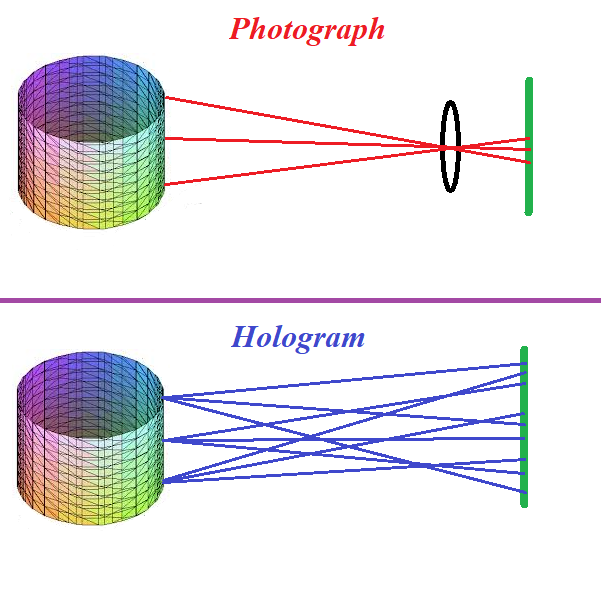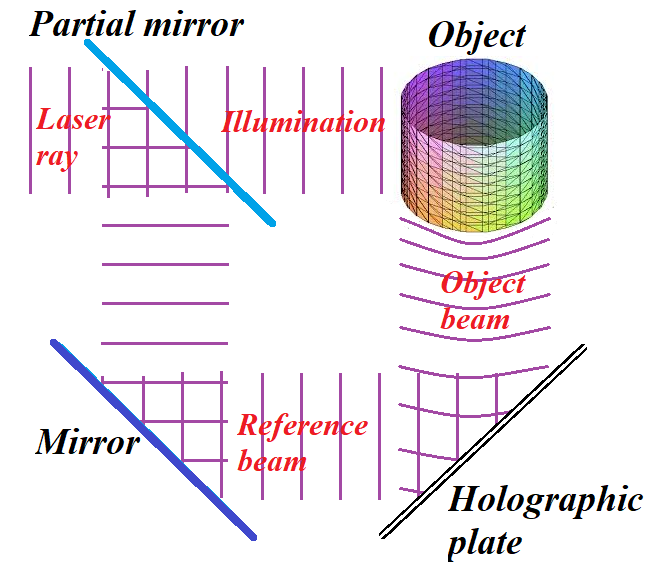Holography
Holography is a technique that allows creation of three-dimensional (3D) images of objects, holograms, by recording and later on displaying all the light reflected from these objects.
Ability to record and display all the light reflected from these objects is what differentiates the hologram from a photograph, which records only the light reflected by an object towards the camera.
That is the main distinction between a holographic 3D image and a flat two-dimensional (2D) photograph.
The following two pictures reflect the above distinction.
The top picture is a schematic representation of the formation of a photographic image with only light beams reflected from an object towards a camera lens get recorded.
The bottom picture represents the main feature of a holographic image with all light beams reflected from an object towards any small area of a recording screen being recorded within this small area, representing a view of an object from this particular viewpoint.

When we see a real object with our eyes, we can see it in 3D space because our two eyes see it at different angles and we can move the eyes to look at different parts of an object, every time changing the angle of observation.
The previous lecture discussed the method of creating the holographic image of a point light. This principle is used to record and recreate an image of any object.
As was explained in the previous lecture, a point light holography is based on interference of two lights - one monochromatic light from a point light itself (all rays are emitted in phase) and another one, as a set of parallel rays of light of the same wave length and in phase with one central ray emitted by a point light.
That was sufficient to create an interference picture on a screen that contained all information needed to recreate an image of a point light, when it's no longer there, by the same set of parallel rays.
Consider any point on a surface of any object. If some monochromatic light, called illumination beam, is directed on it, it will reflect this light in all directions similar to a monochromatic point of light we talked about before.
Therefore, with the help of a set of parallel lights of the same wavelength, called reference beam, we can record the location of this point on a screen similar to the one we used for a point light hologram.
Since the illumination beam illuminates all surface points of an object, all of them will be represented on a screen as an interference picture between two beams.
Next we process the screen surface to develop this interference picture.
To recreate all these points, we will use the same reference beam directed towards a screen, and interference between this beam's rays and rays reflected by a screen.
To produce both beams, illuminating and reference, that should be coherent (same wavelength and phase) we can use partially reflecting mirror that splits the same beam into two separate ones, one for illumination and another as a reference.
Schematically, it can be arranged as on a picture below.

(you can click the right mouse button and open this picture in another tab for better view)
Since every point of an object, reflecting an illumination beam, can be viewed as an independent point light, its holographic image will be created on a screen exactly the same way as described in the previous lecture about point light hologram.
This will be sufficient to recreate each such point by the same reference beam at exactly the same point in space, when the object is no longer there.
The above description of holography is very basic, without any technical details and is intended only as a an explanation of a main concept behind this technology.
Issues like color and moving objects are outside the scope of it and require much more technical details addressed by professionals.


No comments:
Post a Comment